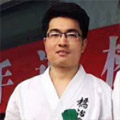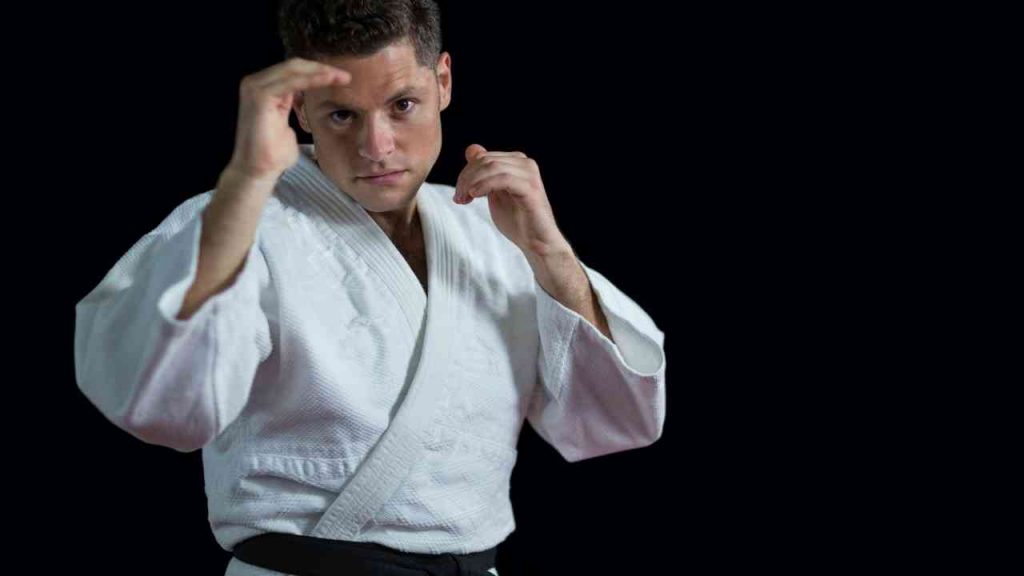Do you know Wado Ryu Karate has a blended style of both Shindo Yoshin Ryu Jujutsu and Okinawa? Yes, that’s true because it has evolved from time to time. Starting from Okinawa to Japan, it has faced many changes in its style.
The karate – Wado Ryu – name stands for the ‘Way of Harmony or Peace.’ The reason, it stands from the rest is that it especially focuses on promoting harmony.
Moreover, the thing that fascinates me in this karate style is its principles like Maai, Tai Sabaki, etc., and some body movements for self-defense.
Let’s dive in to know more about Wado-Ryu, its history, founder, belt ranking, and more.
Table of Contents
What Is Wado Ryu Karate?
Wado Ryu Karate is a traditional Japanese Karate style that focuses on dodging or controlling the opponent’s attack for self-protection. Rather than using physical strength alone, you should maintain body discipline while performing certain karate techniques. However, other karate styles focus more on punching; it is based on the principle that backing down is more effective than brutal strength. Additionally, it involves shorter natural stances like joints and locks of Jiu Jitsu-style techniques.
Brief History of Wado Ryu Karate
As you know, karate was first developed in Okinawa. But do you know how it reached Japan?
Well, it’s due to cultural exchange between China and Japan. Until now, it has had many different forms and styles, practiced in different karate schools. Wado Ryu is one of those Karate styles.
Shindo Yoshin-Ryu (Jujutsu style) reflects the basis for the Wado Ryu. If we consider the Jujutsu, it was developed by Yoshitoki Akiyama. He traveled to China, where he learned Chinese healing methods as well as fighting techniques.
One day while he was sitting, he observed a willow tree. He noticed that the willow tree didn’t have any broken branches despite the snowfall. When the weight of the snow becomes heavier, it bends for it to fall off. This observation led him to develop a new technique of Karate, Jujutsu which then evolved into Wado Ryu.
Founder
Hironori Otsuka laid the foundation of this karate style. He started studying Shindo Yoshin Ryu Jujutsu under Tatsusaburo Nakayama. Later he became the chief instructor for Shindo Yoshin Ryu Jujutsu.
After he studied Karate under Master Gichin Funakoshi in 1922 and under Choki Motobu and Kenwa Mabuni in 1939, he developed his style of Karate called Wado-Ryu
Hironori Otsuka got inspired by Okinawa’s karate. He found out that Okinawa’s Karate has different techniques from Jujutsu and vice versa. So it came to his mind to merge both and to apply the techniques of Jujutsu to Okinawa’s Karate. That’s why Wado-Ryu was the result of combining both of these styles.
Wado Ryu Belt Order
The belt ranking system for Wado Ryu Karate is as follows:
| Level | Belt Color | Kata |
|---|---|---|
| Hachikyu – 8th Kyu | Yellow Belt | First grade. Kihon, no Kata or basic Kata |
| Sichikyu -7th Kyu | Orange Belt | To earn the belt the kata is Pinan Nidan |
| Rokyu – 6th Kyu | Green Belt | The Kata for this rank is Pinan Shodan, Pinan Shandan |
| Gokyu – 5th Kyu | Blue Belt | Pinan Shodan, Yondan |
| Yonkyu – 4th Kyu | Purple Belt | Students have to pass this Karate test Pinan Godan, Yodan for this rank. |
| Sankyu -3rd Kyu | Brown Belt- 1 stripe | Pinan Godan |
| Ni Kyu-2nd Kyu | Brown White Belt- 2 stripes | Kushanku |
| Ik Kyu-1st Kyu | Brown Black Belt-3 stripes | Naihanchi |
After you have achieved these levels, students step further into Black ‘Dan’ levels. Black belt has 10 different levels starting from Shodan, Nidan, Sandan, Yondan, Godan, Rokudan, Nanadan, Hachidan, Kudan, to lastly Judan.
Wado Ryu Karate Techniques
Wado Ryu Karate Katas
Wado Ryu had 16 katas originally, but later Superimpei Kata was removed. Now 15 Katas are practiced. The top ones are:
The Pinan Series: Pinan means ‘peaceful mind’. In the 1900s, Anko Itosu developed the pinan series. Itosu learned these and formulated them into five katas named Pinan. These are:
- Pinan Nidan
- Pinan Shodan
- Pinan Sandan
- Pinan Yondan
- Pinan Godan
- Kushanku: It is one of the longest katas forms and a requirement for brown belt gradings and upwards.
- Naihanchi: It has the meaning of ‘surreptitious steps’ or ‘sideway fighting.’ It is the most effective technique among all.
- Seishun: It is the oldest kata that employs self-defense techniques with a focus on foot movements. It means ’13 hands’.
- Chinto: Chinto makes the students learn many throwing techniques as well as maintain stability and balance. Gini Funakoshi taught it to Ohtsuka.
- Wanshu: Wanshu kata takes its name from a Chinese envoy who came to Okinawa in 1600. He stayed there and taught Shaolin White Crane Kempo.
Wado Ryu Karate Stances
- Chinto dachi – Chinto stance: For this stance, the heels should be on the same line. The length from one heel to the other is 1.5 times the width of the shoulders.
- Fudo dachi – Free stance: Here, you let the back knee bend to make it closer to the rear ankle.
- Gankaku dachi (or Sagi ashi dachi) – Crane or heron stance: Translated as ‘crane on rock’. It has many fast attacks but at the same time has slow postures as well to bring calmness.
- Gyaku Neko Ashi dachi – reverse cat stance: In this stance, weight lies more on foot and rear knee points inwards.
- Gyaku zuki dachi – reverse punch stance: Here also weight is more on the front foot while it also points in slightly.
- Gyaku zuki tsukkomi dachi -Reverse lunge: The front feet lie even with the rear perpendicular to the attack line.
- Hachiji dachi – Ready stance: Toes pointed out a little bit. Feet and shoulders are a width apart.
- Hangetsu dachi – Half-moon stance: If your opponent is in front of you then your toes should be in a position to their center.
- Hanmi Neko Ashi dachi – Half turned cat stance: Here the back foot points to the side, and hips are positioned at an angle called Hanmi.
- Heiko dachi: It is the parallel stance in which feet are apart at the length of one foot.
Wado Ryu Karate Kicks
- Mawashi Geri (Roundhouse kick): It can hit a wide range of targets at different heights due to speed, power, and ability.
- Hiza Geri (Knee strike): Used when one cannot extend their legs because opponent is quite close to you.
- Mae Geri (Front kick): It is a very basic kick for self-defense.
- FumiKomi (Stomp Kick): Used to attack an opponent’s knee, thigh, and foot.
- Kin Geri (Groin Kick): This kick targets the groin area as well as the inner thighs.
- Kansetsu Geri (Joint Kick): Targets at the side or back of an opponent’s knee.
- Ushiro Geri (Back kick): Target the back of the kicker and is less accurate.
- Ashi Bari (Foot Sweep): Knocks the opponent’s balance off the ground
- Kakato Otoshi Geri (Axe Kick): Targets the head or shoulder bone of the opponent.
- Mikazuki Geri (Crescent Kick): Targets the opponent’s head or collar bone.
Wado Ryu Karate Punches
- Zuki (Tsuki) (punch)
- Empi (elbow strike)
- Gyakuzuki (reverse punch)
- Haishu (back hand)
- Haito (ridge hand)
- Hitosashi Ipponken (knuckle strike – 2nd knuckle of index finger)
- Ippon Nukite (one finger spear hand)
- Junzuki (forward punch)
- Koken Uchi (wrist strike with the back of the bent wrist)
- Maewashi Zuki (roundhouse punch)
Wado Ryu Karate Kumite
- Ipponme or Kihon 1: Required to get the yellow belt, green belt and orange belt, 3rd Kyu brown belt
- Nihonme or Kihon 2: Required to get the blue belt, 3rd Kyu brown belt, black belt 1st Dan
- Sanbonme or Kihon 3: Required to get the purple belt, 2nd Kyu brown belt, black belt 1st Dan
- Yonhonme or Kihon 4: To obtain 2nd and 3rd Kyu brown belt
- Gohonme or Kihon 5: To acquire 2nd Kyu brown belt
- Rapponme or Kihon 6: To acquire 1st Kyu, 2nd Kyu brown belt, black belt 2nd Dan
- Nanahonme or Kihon 7: To acquire 1st Kyu brown belt
- Hachihonme or Kihon 8: Required to her 1 and 2 Dan belt
- Kyuhonme or Kihon 9: Required to get 3rd Dan belt
- Jipponme or Kihon 10: Required to get higher Dan belts – upwards from 3rd one.
Is Wado Ryu Karate effective for self-defense in a real fight?
Yes, it can help you with self-defense in real fights. Because it not only focuses on body positioning but also involves joint and lock stuff. So the combination of both will give you strength in a real battle to counterattack the opponent.
Wado Ryu Karate Books
Here are top 3 recommended Wado Ryu Karate Books:



Final Words
Wado Ryu Karate is one of the versatile Karate Styles. Unlike others, it emphasizes body positioning to avoid attacks and focuses on harmony. No doubt it will take time to learn the art, but once you master it, you will find mental and physical strength within yourself.
Curious more karate styles, check out the article: 13 Main Karate Styles and Their Differences.


